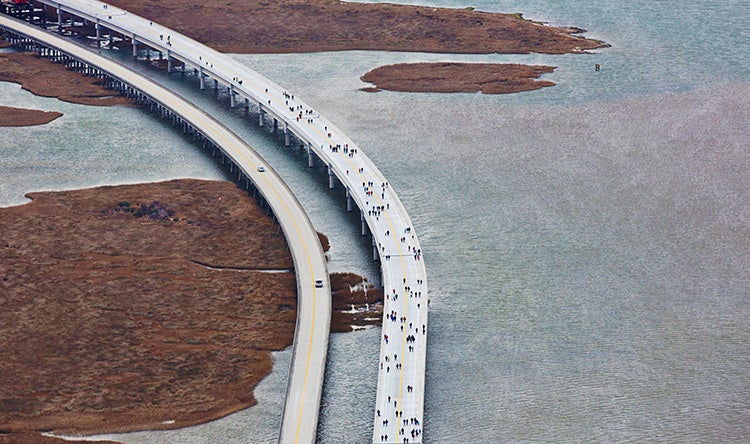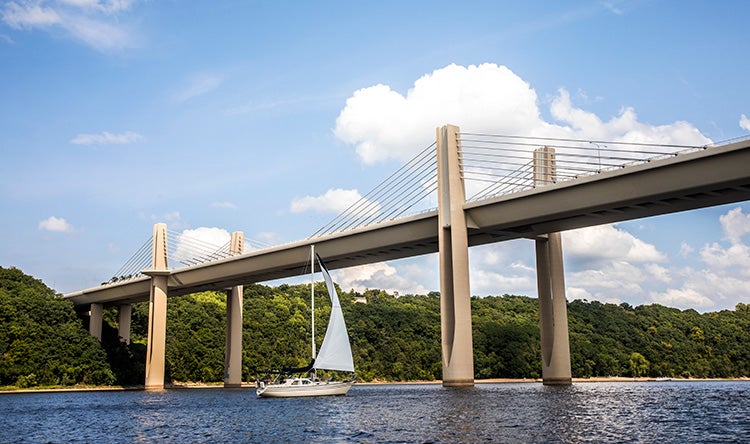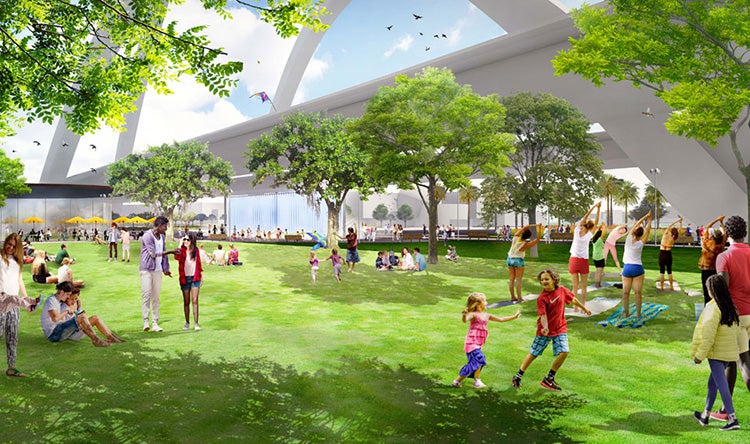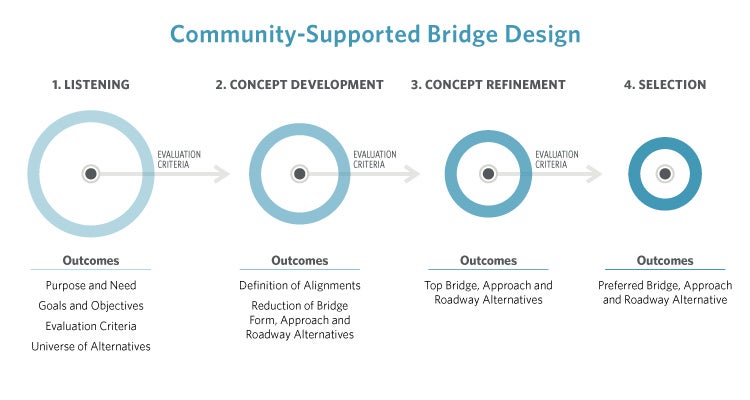
Designing Iconic Bridges by Listening
Matching Community Aspirations and Budgetary Realities: How Owners and Residents Benefit when Bridges are Designed in Partnership with Their Users
By Michael Fitzpatrick and Jimmy Vincent
At their core, bridges are about providing safe and efficient connections. Their function in connecting Point A to Point B is clear. But their form is also significant, and bridges that recognize the importance of design and aesthetics connect on a deeper level with their communities.
As the U.S. embarks on replacing its aging infrastructure, we have an opportunity to design bridges that serve more than a utilitarian purpose. Bridges can be a mechanism for communities to express their character, even as they meet budgetary realities and technical requirements. Accomplishing this dual goal requires a multi-disciplined and collaborative team who can navigate the technical or quantitative requirements of public owners as well as the qualitative or cultural expectations of a community.
Bridge Design That Elevates Communities
Designing a replacement or new bridge that embodies the character that a community expects while remaining within the owner’s budget can be seen as an insurmountable (if not unwanted) task. While “practice makes perfect” would be helpful, many owners and communities do not regularly undertake large transportation projects. In addition, while lessons learned from previous projects are helpful, each site and community have unique goals and needs to be addressed.
Some locations need a multimodal bridge that matches a dense urban landscape. Others may need a low-profile bridge to blend with a sensitive environmental area. Other communities may be interested in not just a bridge for vehicles, but the opportunities it opens for the space adjacent to the vehicle lanes or underneath the bridge. Large, community-defining bridges must recognize these different requirements. The best bridge design uses an approach that does more than meet the technical requirements for a bridge; it creates a structure that connects with communities emotionally as well as practically.
Invest in Collaboration Early in the Project Development Phase
Achieving these goals — while recognizing budgetary and schedule realities — begins with forging a strong connection between the designer, bridge owner and the community where a bridge will stand. Project teams should seek to understand the community’s needs, help residents understand the budget and schedule constraints of a project, and then partner with them through the design process. For owners, this process can be beneficial in multiple ways:
- Inspire community appreciation: Many new complex bridges are designed to last 100 years or more. Public owners such as DOTs or cities can build significant goodwill with those who will use and live next to the bridge for the next century by emphasizing beauty as well as functionality. In North Carolina, the opening of the Marc Basnight Bridge attracted thousands of local residents, even on a cold, gray winter day to celebrate this new landmark.

Residents walk across the recently completed Marc Basnight Bridge in February 2019. The North Carolina Department of Transportation bridge replaced an aging, deteriorating bridge on the Outer Banks.
Photo courtesy PCL Construction - Build community acceptance: Bridges designed to meet community needs and to fit within their environment are also accepted more readily by communities, including stakeholder groups that may need to approve any final design. In addition, working with the community to address concerns that arise can also help avoid litigation or opposition that can delay or derail projects. Opponents of the St. Croix Crossing connecting Minnesota and Wisconsin worried about its environmental impact, but careful listening and conscientious design meant the finished bridge fits with its scenic setting. Today, it is embraced by the locals and a popular destination for those looking to walk or run across the bridge while taking in the beautiful views offered by this Wild and Scenic River.

Designed to fit its environment, the St. Croix Crossing, built for the Minnesota and Wisconsin Departments of Transportation, uses an unusual extradosed design to reduce the number of pier supports. Other design choices include rounding corners to provide a streamlined look, subdued night lighting and an earth-tone color that helps blend with the surroundings. - Create community amenities: In many cases engaging with a broad cross section of stakeholders about their overall needs in the project area can uncover additional opportunities to enhance the project design and deliver added value. A holistic design approach ensures new or rehabilitated bridges meet local goals beyond establishing a safe connection. For instance, improving transit access, creating new public space or improving water quality could be cost effectively incorporated. In Miami, when the reconstruction of I-395 Signature Bridge is complete, the structure will not only provide more efficient travel for drivers, it will also create a new downtown park that reconnects neighbors that had been separated by the highway decades earlier.

The I-395 signature bridge designed for the Florida Department of Transportation includes a 33-acre park, with amenities for residents and visitors. Once complete, the Heritage Trail will connect multiple neighborhoods of Miami through a contiguous trail that includes community activity areas.
Rendering courtesy Connecting Miami JV | Archer Western-deMoya Group
Community-Supported Bridge Design
Balanced with the program limitations of the bridge owner, HDR's process of community input and connection consists of four broad steps:
- Listening
- Concept Development
- Concept Refinement
- Selection

1: Form-Finding Through Listening to Communities’ Values
The first step begins with listening to stakeholders, learning what they value and what is most important to them. Public outreach meetings and surveys offer a voice to those who will be using the bridge. But these meetings are a two-way conversation. The community is also educated on the requirements and constraints of the project. Creativity and big ideas are encouraged while recognizing that budgets must be met.
Questions about the qualities of space important to community members and what resonates with them on an emotional level help inform key aesthetic design features that embrace a community’s culture. By asking for reactions to precedent images of a wide variety of bridge types, from very straightforward to unusual, designers can discover what a community would like to see.
While the process is about form-finding, it is a form-finding based on creating an emotional response. Success begins with this stage, discovering what a community feels about the site and shaping the bridge accordingly. At the end of this step, we develop selection criteria or design objectives that are later used to evaluate possible concepts.
2: Challenging Traditional Design through Interactive and Responsive Concept Development
The second step, concept development, explores a wide range of options, including concepts that may challenge traditional engineering standards and materials. This step pushes the boundaries of what’s possible while keeping in mind the needs of the project and the desires of the community.
Technology such as parametric design and smart models helps develop ideas into possible solutions. Close coordination with owners as well as stakeholders and community groups guides this process, using public meetings, votes, presentations and more. At the end of this step, the bridge concepts are reviewed based on the criteria developed. Some are eliminated, others are merged, and some are kept with suggested improvements.
3: Aesthetic Design Meets Engineering Refinement to Balance Costs, Quality and Value
Next, the concepts are refined. Engineering expertise is applied to guide continued development, and cost ranges are developed with more confidence to meet budgetary constraints. More details are determined, such as lighting, colors, or size of specific elements.
This third step begins to take ideas from concept stage to more detailed design. As the refinement continues, some concepts continue to be eliminated based on identified criteria or community input. At the end of this step, a limited number of concepts are advanced.
4: Selection Based on Community and Owner Requirements
The final step in creating a bridge design shaped by and built for its community is selection. This step begins with a small number of final concepts — three or fewer — which are vetted with the owner and presented to project stakeholders.
Images, models and even virtual reality simulations may be developed to help visualize the possibilities. After selection is finalized by the owner, engineering work continues to take the selected concept from preliminary to final design.
From Bridge to Iconic Structure, Customized to Each Community
Iconic structures are not reasonable for every location and clearly do not rise overnight; their creation requires a strong combination of dedicated collaboration, design vision and technical know-how.
From start to finish this process of developing bridge concepts in partnership with the owner and community takes six to nine months. It involves formal methods such as environmental justice work and public outreach efforts, as well as in-depth discussions with stakeholders impacted by the bridge and ongoing collaboration with the bridge’s owner.
A custom-built bridge team involving specialized planning, design and engineering expertise helps owners navigate this complex process. The result is a bridge design customized to each community that considers local transportation needs, site conditions, weather, the visual landscape, unique cultural aspects and more.
A better understanding of a community’s hopes, aspirations and reasons for a bridge starts with listening and leads to better planning, better design and a community asset that is loved for generations.
About the Authors
Senior project manager Michael Fitzpatrick, AAIA, has brought his architectural vision to a wide variety of transportation projects over the past 25 years, including pedestrian facilities, specialty structures and long span bridges. He is responsible for the visual quality of structures, coordinating corridor aesthetics and providing context sensitive design. An experienced consensus builder, his projects often include large amount of public involvement throughout the design process.
Transportation project designer Jimmy Vincent is an experienced designer and visualization creator. He works with project teams to help clients and the public visualize design concepts and their impact.


